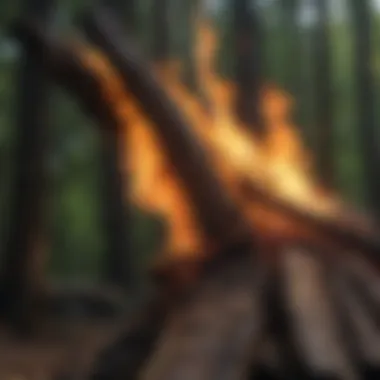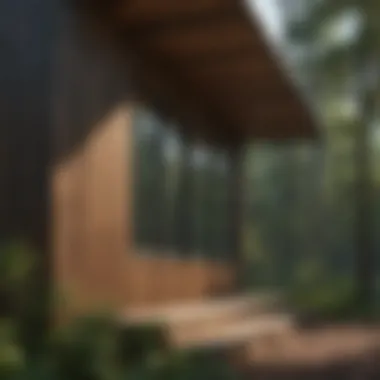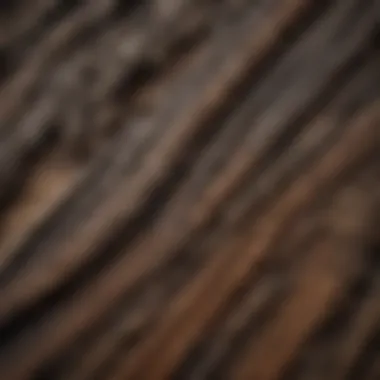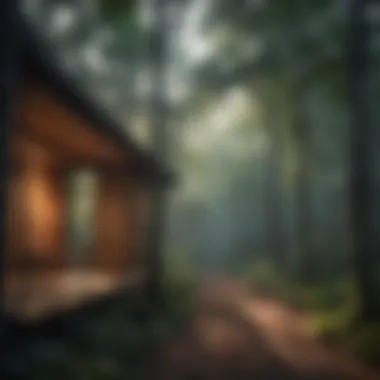A Deep Dive into Sugi Ban Siding Techniques


Intro
The ancient practice of Sugi Ban siding represents a unique intersection of craftsmanship and ecological conservation. Originating in Japan, this method involves charring wood surfaces to enhance durability while developing an aesthetically pleasing texture. It is not merely a technique for improving wood; it is emblematic of a cultural ethos that values both the material and its source.
This article examines the multifaceted aspects of Sugi Ban siding. It will shed light on its historical significance, explore its implications for contemporary design and sustainable practices, and consider the essential role it plays within a broader ecological context. By integrating depth with clarity, this exploration serves to underscore the relevance of Sugi Ban in today's world of construction and environmental stewardship.
Forest Ecology and Biodiversity
Understanding the relationship between Sugi Ban siding and forest ecology is crucial to comprehending its full impact. Forest ecosystems play a vital role in supporting a rich diversity of flora and fauna.
Importance of Forest Ecosystems
Forests are not only critical for biodiversity, but also provide essential services such as carbon sequestration, water filtration, and soil stability. The interplay between tree species, underbrush, and wildlife leads to a balanced ecosystem.
Flora and Fauna in Woodlands
In forests, various species coexist, forming intricate relationships. Native plants and animals depend on these habitats for survival. The preservation of these ecosystems directly influences the material quality used in Sugi Ban siding, emphasizing the need for sustainable forest practices.
Sustainable Forestry Practices
Sugi Ban siding encapsulates the ethos of sustainable forestry in each piece crafted. Responsible management techniques contribute to the longevity of forest ecosystems.
Techniques for Responsible Management
Practices such as selective logging and reforestation ensure that forests can regenerate and continue to thrive. Techniques like these foster a balance between usage and conservation, making Sugi Ban a relevant topic in today’s sustainability discourse.
Certification Schemes and Standards
The importance of certification schemes cannot be understated. Organizations like the Forest Stewardship Council (FSC) set standards that promote responsible forest management. These certifications provide assurance that Sugi Ban siding materials are sourced ethically, directly linking craftsmanship to environmental stewardship.
Community Engagement and Stewardship
The role of local communities in promoting sustainable forestry and Sugi Ban siding cannot be overlooked. Their active participation is essential for the successful conservation of local woodlands.
Role of Local Communities
Communities that engage in forest management often possess traditional knowledge that enriches sustainable practices. By aligning local interests with ecological health, these communities contribute to more resilient forest ecosystems.
Volunteer Opportunities for Engagement
Opportunities for volunteer involvement abound. Many organizations seek assistance in reforestation projects and educational initiatives focusing on the traditions of Sugi Ban. Joining in these efforts can deepen one’s understanding of both the craft and its environmental implications.
"The art of Sugi Ban is not just about shaping wood but also about shaping our relationship with nature."
By delving into these myriad dimensions, this article not only highlights the significance of Sugi Ban siding but also positions it as a key player in the broader narrative of sustainability and ecological awareness.
Prelims to Sugi Ban Siding
Sugi ban siding represents a unique intersection of tradition and innovation. As an ancient Japanese technique, it has garnered attention for its ability to enhance the durability and aesthetic appeal of wood. Understanding sugi ban siding offers insights into not just craft but also broader themes of sustainability and ecological stewardship. In this section, we will examine the definition, historical origins, and cultural significance of sugi ban.
Defining Sugi Ban
Sugi ban refers to the practice of charring wood, specifically the Japanese cedar, to improve its properties. This process creates a protective layer that makes the wood more resistant to weathering, insects, and decay. The technique is not merely a treatment; it is a craft that transforms ordinary wood into a more resilient material. The method involves controlled burning to achieve a specific finish. This contributes to a unique texture and dark color that many find appealing.
Historical Origins


The origins of sugi ban can be traced back several centuries. Initially utilized for practical purposes, the method evolved as artisans recognized its aesthetic potential. Sugi ban techniques can be linked to the architectural practices of the Edo period, where wooden structures thrived due to their ability to withstand Japan's diverse climate. The practice was preserved through generations, emphasizing the balance between functionality and beauty. Today, it reflects a deep respect for materials and methods that connect craft with a sustainable ethos.
Cultural Significance in Japan
In Japan, sugi ban holds more than technical value. It symbolizes a connection to nature, craftsmanship, and cultural heritage. The use of sugi ban in traditional structures speaks to a broader understanding of materials in architecture. This method has also become integral to various art forms, ensuring its relevance even in contemporary design. Furthermore, sugi ban siding often serves as a celebration of simplicity and environmental awareness—core components of Japanese aesthetics. It shows how ancient techniques can inform modern practices in a way that respects past knowledge while addressing today's needs.
"Understanding sugi ban is to appreciate how traditional methods intersect with contemporary needs, reinforcing the value of sustainability in our built environment."
In summary, the introduction to sugi ban siding provides a foundation for understanding its relevance in both historical and modern contexts. As we continue to explore the technique, its applications, benefits, and implications will become clearer, illuminating its place in contemporary architecture and forestry management.
The Sugi Ban Technique
The Sugi Ban technique holds a significant place in the realm of wood treatment. This traditional Japanese method enhances the lifespan of wood through a carefully controlled burning process. Understanding this technique is crucial as it affects both the functional properties and the aesthetic qualities of the wood. It seamlessly integrates ancient craftsmanship with modern architectural demands, making it relevant for today’s design practices.
Materials Used
The materials utilized in Sugi Ban siding are primarily based on Japanese cedar, known as Sugi. This type of wood is favored for its natural resistance to rot and insects. The choice of wood is pivotal because it inherently contributes to the durability of the finished product. Alongside the Sugi wood, the technique requires:
- Fire retardants: Often applied after the initial treatment to enhance safety against fire hazards.
- Finishing oils: Used post-treatment for additional protection and visual enhancement. This ensures that the wood maintains its rich texture and color while adding a layer of defense against environmental elements.
Step-by-Step Process
The Sugi Ban process is methodical, demanding precision for effective results. It involves several key steps:
- Preparation of the Wood: The wood is cut and dried to reduce moisture content. This step is essential as it ensures an even burn.
- Burning Process: The wood surface is charred using an open flame or torch. This stage should be carefully monitored to achieve an even layer of carbonization without compromising the wood's structural integrity.
- Cooling and Cleaning: After burning, the wood needs to cool. Once cooled, excess char is brushed off to create a smooth finish.
- Application of Finishing: Finally, natural oils or water-repellent finishes are applied to seal the wood, enhancing its longevity and maintaining its appearance.
Skills and Tools Required
Implementing the Sugi Ban technique necessitates both craftsmanship and specific tools. Key skills include:
- Woodworking Skills: Sufficient knowledge of wood properties and handling ensures the selection of quality wood and proper preparation.
- Fire Management Skills: Mastery of managing flames and understanding how heat affects wood is crucial during char-to-burn phases.
- Finishing Skills: Knowledge of applying finishing products correctly preserves the wood while augmenting its beauty and function.
Furthermore, essential tools for this process include:
- Burning Torches or Flame Guns: For the precise application of heat.
- Brushes: For cleaning the charred surface after burning.
- Protective Gear: Safety gloves and goggles to ensure the operator's safety during the burning process.
The Sugi Ban technique exemplifies how ancient methods can address modern building standards while promoting sustainability in material use.
Benefits of Sugi Ban Siding
Sugi Ban siding offers numerous advantages, making it a compelling choice for Architects and builders. This traditional technique not only enhances the durability of the wood but also provides a unique aesthetic appeal. Furthermore, the sustainability aspects of Sugi Ban siding position it at the forefront of modern architectural practices focused on ecological considerations. Each of these benefits plays a significant role in its growing popularity in contemporary construction.
Durability and Weather Resistance
One of the most notable benefits of Sugi Ban siding is its exceptional durability. The process of burning the wood creates a protective layer of char, which inherently increases its resistance to decay and insect infestation. This charred surface acts as a barrier against moisture, effectively reducing the risk of mold and rot. Consequently, buildings clad in Sugi Ban can withstand harsh weather conditions over extended periods, making it an ideal material for various climates.
Importantly, numerous studies highlight the longevity of Sugi Ban siding. When treated correctly, it can last well beyond the lifespan of untreated wood siding. This durability not only ensures lower maintenance costs over time but also leads to fewer resources being expended on repairs or replacements. Hence, embracing Sugi Ban means embracing an efficient building solution that speaks to both practicality and cost-effectiveness.
Aesthetic Appeal
Beyond its functional benefits, Sugi Ban siding also draws attention for its striking visual qualities. The unique textures created through the charring process result in a diverse range of finishes, from deep black to rich browns. This variability allows for creative expression in design, making it suitable for both contemporary and traditional architectural styles.
The visual appeal of Sugi Ban does not go unnoticed in the realm of design. It offers a rustic yet refined finish that can enhance the character of any structure. As architects increasingly prioritize aesthetics in their designs, Sugi Ban siding becomes a preferred choice among many. The natural aging process also adds a layer of charm, as the surface develops a patina over time, creating a sense of history within the building.
Sustainability Aspects


Sugi Ban siding embodies sustainability through its use of natural materials and its environmentally friendly treatment process. This technique utilizes readily available wood, typically sourced from managed forests, ensuring that the ecological balance is maintained. The controlled burning process requires minimal energy compared to other wood treatment methods, contributing to a lower carbon footprint.
The environmental benefits extend beyond production. Sugi Ban's long-lasting nature means fewer resources are consumed over time. Homes and buildings crafted with Sugi Ban contribute to a reduction in waste, reinforcing the concept of building responsibly. Additionally, as the demand for sustainable materials rises, Sugi Ban siding aligns with the growing trend for eco-conscious construction practices.
"Using Sugi Ban siding is not just a choice for today; it reflects a commitment to preserving our environment for future generations."
Applications in Modern Architecture
The integration of sugi ban siding into modern architecture signifies a bridge between ancient craftsmanship and contemporary design sensibilities. This technique not only elevates the aesthetic value of structures but also aligns with increasing environmental consciousness. Sugi ban, with its origins steeped in Japanese tradition, brings both functional and cultural attributes to various types of buildings, enhancing their overall appeal and sustainability.
Residential Use
In residential architecture, sugi ban siding has gained popularity among homeowners who seek unique and durable materials. The charred finish of the wood provides a distinctive look that melds well with natural surroundings. It creates a warm and inviting atmosphere while simultaneously offering protection against weather conditions.
The benefits include:
- Low Maintenance: Sugi ban wood requires less upkeep compared to untreated wood, as the charring process helps to repel pests and resist decay.
- Thermal Efficiency: The insulating properties of the charred wood contribute to energy efficiency in homes, maintaining comfortable indoor temperatures.
- Health Implications: The natural properties of this siding are said to release fewer volatile organic compounds (VOCs), promoting better indoor air quality.
Commercial Use
In commercial settings, sugi ban siding appeals to businesses looking for a striking design that stands out while also providing durability. Restaurants, boutiques, and corporate offices are increasingly adopting this style. The aesthetic versatility of sugi ban allows it to fit various architectural themes, from rustic to modern.
Key advantages include:
- Branding: Companies can leverage the uniqueness of sugi ban to enhance their branding, creating a memorable identity that resonates well with clients.
- Longevity: The fire-treated wood holds up extremely well under various weather conditions, reducing the need for replacement.
- Eco-Friendly Image: Utilizing sugi ban aligns a business with sustainability, appealing to environmentally conscious consumers.
Public Spaces
Sugi ban siding is also finding a place in public buildings and spaces, such as parks, museums, and community centers. The technique not only adds to the visual impact of these structures but also fosters a sense of connection to nature.
In public applications, the following aspects are especially impactful:
- Cultural Connection: Incorporating sugi ban in public architecture pays homage to traditional Japanese techniques, enriching the cultural narrative of the space.
- Safety: The fire-resistant qualities of charred wood are vital for public buildings, enhancing safety measures in communal areas.
- Community Engagement: Buildings designed with sugi ban can foster community interaction and appreciation of craftsmanship, opening dialogues about environmental sustainability.
Sugi ban siding serves as a testament to how traditional techniques can be dynamically utilized in modern architecture, providing not only functionality but also deep cultural relevance.
The applications of sugi ban siding in modern architecture demonstrate its versatility and enduring appeal. As designers and builders seek to incorporate sustainable materials, sugi ban stands at the forefront, merging past artistry with present-day needs.
Ecological Implications
Understanding the ecological implications of Sugi Ban siding is crucial not only for the material's use but also for its broader impact on the environment. This section will discuss the specific elements that involve forest management, biodiversity, and the long-term environmental benefits associated with the application of this wood treatment technique.
Impact on Forest Management
Sugi Ban, a technique that involves charring the surface of cedar wood, serves as a valuable tool in forest management. By utilizing this method, we can enhance the lifespan of timber products without extensive chemical treatments. This approach promotes sustainable forestry practices, allowing for the preservation of natural resources. Moreover, the demand for Sugi Ban treated wood encourages the careful management of cedar forests, leading to improved stewardship and sustainable harvesting methods. This way, the technique not only benefits the users but also reflects a responsible approach towards forest ecology.
Biodiversity Considerations
The application of Sugi Ban siding may also have positive effects on local biodiversity. Forests managed sustainably, with methods including Sugi Ban, create habitats that can support a variety of species. These important habitats contribute to a balanced ecosystem. When forests are treated in a manner that encourages regrowth and minimal chemical interference, the potential for preserving native species increases. However, it is critical to ensure that the practice of Sugi Ban does not lead to overharvesting or excessive depletion of resources, which can negatively affect the biodiversity of forested areas.
Long-term Environmental Benefits
The long-term environmental benefits of Sugi Ban are noteworthy. Charred wood is naturally resistant to decay, which means that buildings and structures featuring this material require less frequent replacement. This durability complements sustainability goals. Furthermore, using local species like Japanese cedar minimizes the carbon footprint associated with transporting materials. Over time, these practices reduce the overall environmental impact compared to traditional wood treatment methods. Ultimately, Sugi Ban siding embodies a proactive approach to environmental conservation, nurturing the interplay between human needs and ecological preservation.
In summary, the ecological implications of Sugi Ban siding illustrate a multi-faceted relationship between wood treatment techniques and environmental health. Understanding this relationship is vital for advancing sustainable architectural practices.


Challenges and Considerations
Understanding the challenges and considerations surrounding Sugi Ban siding is crucial as it leads to better decision-making for professionals and enthusiasts alike. This ancient wood treatment technique has much to offer, but it also comes with its own set of hurdles that should be acknowledged. Evaluating these challenges ensures that one can make informed choices in their application and promotes a more sustainable use of resources.
Safety Concerns
When implementing Sugi Ban siding, safety must be prioritized. The process of charring wood involves open flames, which can present risks if proper precautions are not taken. This includes ensuring proper ventilation, especially in enclosed spaces where the fumes from burning wood can accumulate.
Moreover, the fire treatment can create splinters and rough surfaces on the wood. Those working with the treated material should wear appropriate personal protective equipment such as gloves and masks to prevent injuries and inhalation of harmful particles. It is vital to educate workers about the potential hazards and the importance of safety measures in handling both the materials and equipment used in this technique.
Cost Implications
Cost is another significant consideration when opting for Sugi Ban siding. The initial investment can be higher than traditional siding methods due to specialized equipment and skilled labor requirements. The cost of sourcing quality wood, particularly cedar, also plays a role in overall expenses.
However, when considering the long-term benefits of using Sugi Ban siding, such as its durability and low maintenance needs, the initial costs can be seen as a worthwhile investment. To mitigate these expenses, it can be beneficial to have a clear project plan and budget. Additionally, leveraging local resources for wood may help in reducing costs.
Regulatory Restrictions
Regulatory factors can also influence the adoption of Sugi Ban siding. In some regions, strict building codes and regulations may limit the use of wood treated with fire. This is often due to concerns about fire hazards associated with charred materials.
Before undertaking any Sugi Ban project, it is imperative to consult local regulations. This will help in understanding the necessary permits and compliance requirements for using this traditional technique in construction. Engaging with local authorities can provide clarity and ensure that the project adheres to all safety and legal standards.
Future of Sugi Ban Siding
The future of Sugi Ban siding holds notable significance in the context of evolving building practices and sustainability prioritization. As the demand for environmentally friendly materials increases, Sugi Ban presents a strong alternative. This ancient technique not only enhances the longevity of wood but also provides an aesthetic that resonates with both traditional and modern design sensibilities.
Trends in Design
In recent years, design trends have shifted towards integration of natural materials into architecture. Sugi Ban siding fits well within this trajectory, providing architects and designers a way to blend artistry with functionality. The charcoal finish of Sugi Ban offers a unique texture and color that enhances visual appeal.
Current trends emphasize a more minimalistic approach, and Sugi Ban siding fits into such frameworks beautifully. Its dark, rich color contrasts nicely with lighter elements often found in contemporary designs. The use of Sugi Ban is increasingly noted in residential projects, where it adds both character and sophistication.
Moreover, eco-conscious design is shaping how materials are selected. As sustainability becomes a standard, Sugi Ban’s natural insect resistance and weather durability make it a prime choice. This alignment with current trends emphasizes how the technique can meet contemporary needs without compromising on traditional craftsmanship.
Potential Innovations
Looking ahead, the potential for innovation within the Sugi Ban community is vast. Approaches to enhance the Sugi Ban technique may emerge. For example, research and development efforts can explore eco-friendly finishes that complement the existing properties of Sugi Ban, further enriching its appeal in modern design.
Additionally, advancements in technology could lead to the creation of new tools for the Sugi Ban process. These tools may improve efficiency, reduce labor costs, or enhance the uniformity of the charred finish. Innovations in wood treatment processes may also arise, further increasing the effectiveness of Sugi Ban in protecting wood from environmental degradation.
Incorporating digital tools for design visualization is another area of advancement. Virtual reality could allow architects to simulate Sugi Ban applications in projects before actual implementation. This kind of interaction will lead to better decision-making regarding material use and design aesthetics.
The ongoing evolution of ecological awareness and building standards presents Sugi Ban siding as not just a traditional method, but a relevant option for modern architectural practices.
In summary, the future of Sugi Ban siding is promising. Embracing current design trends while fostering potential innovations will allow this ancient art to thrive in modern contexts. As the conversation around sustainable practices continues to gain momentum, Sugi Ban could very well position itself as a preferred choice among architects and designers.
End
The conclusion serves as a pivotal section that encapsulates the essence of Sugi Ban siding. This technique is not just a method of treating wood; it represents an intersection of tradition, artistry, and sustainability. In summing up the articles' key points, we emphasize the historical context of Sugi Ban, its unique applications, and the ecological ramifications that extend into modern forestry practices.
Summary of Key Points
- Historical Significance: Sugi Ban's origins illustrate a deep-rooted cultural practice in Japan, reinforcing communal ties and respect for nature.
- Technical Artistry: The process involves precise skills and techniques, underscored by the careful selection of materials and tools. Knowing the right methods can greatly impact the outcome.
- Ecological Awareness: As the world leans toward sustainable practices, Sugi Ban siding serves as a model for eco-friendly building and forest management. Its contributions to carbon sequestration and habitat preservation cannot be ignored.
- Design Versatility: The aesthetic appeal of Sugi Ban woodworks fosters a unique blend of beauty and functionality. In both residential and commercial settings, its visual impact is profound.
- Challenges: While the benefits are numerous, challenges like cost and regulatory issues warrant attention and strategic planning.
Final Thoughts on Sugi Ban Siding
In closing, Sugi Ban siding is more than a technique; it is a lens through which we can examine our relationship with nature. The sublime craftsmanship illustrates not only the beauty of wood but also the deep connections we cultivate with our environment. The revival of traditional practices like Sugi Ban is a testament to the resilience of cultural heritage amidst technological advancements. As we look ahead, the principles of Sugi Ban siding can guide sustainable design practices, influencing thoughtful construction in harmony with ecological stewardship.
"In a time where traditional techniques are often overshadowed by modern alternatives, Sugi Ban serves as a crucial reminder of the wisdom embedded in our ancestral crafts."
Ultimately, integration of Sugi Ban siding into contemporary architecture presents an opportunity for professionals to blend innovation with tradition, ensuring that future developments are both aesthetically pleasing and ecologically responsible.















